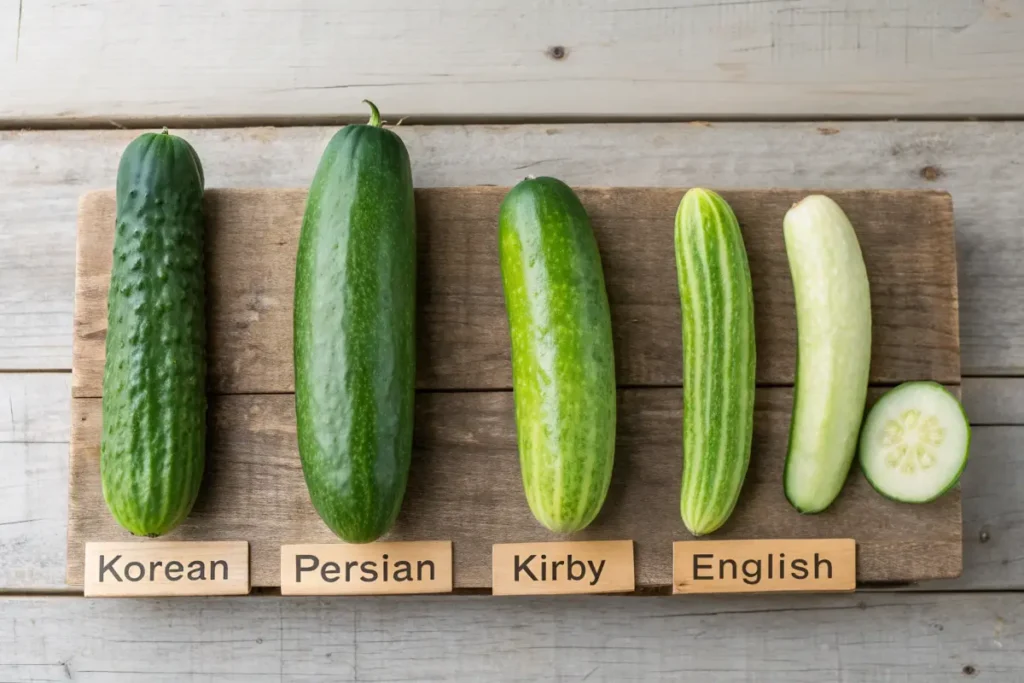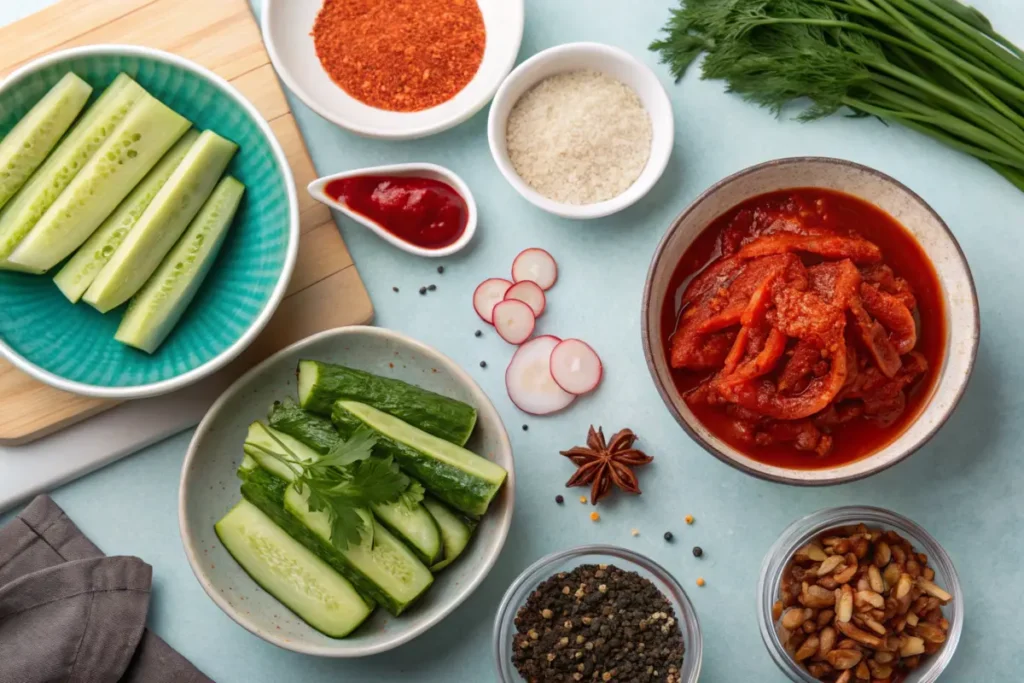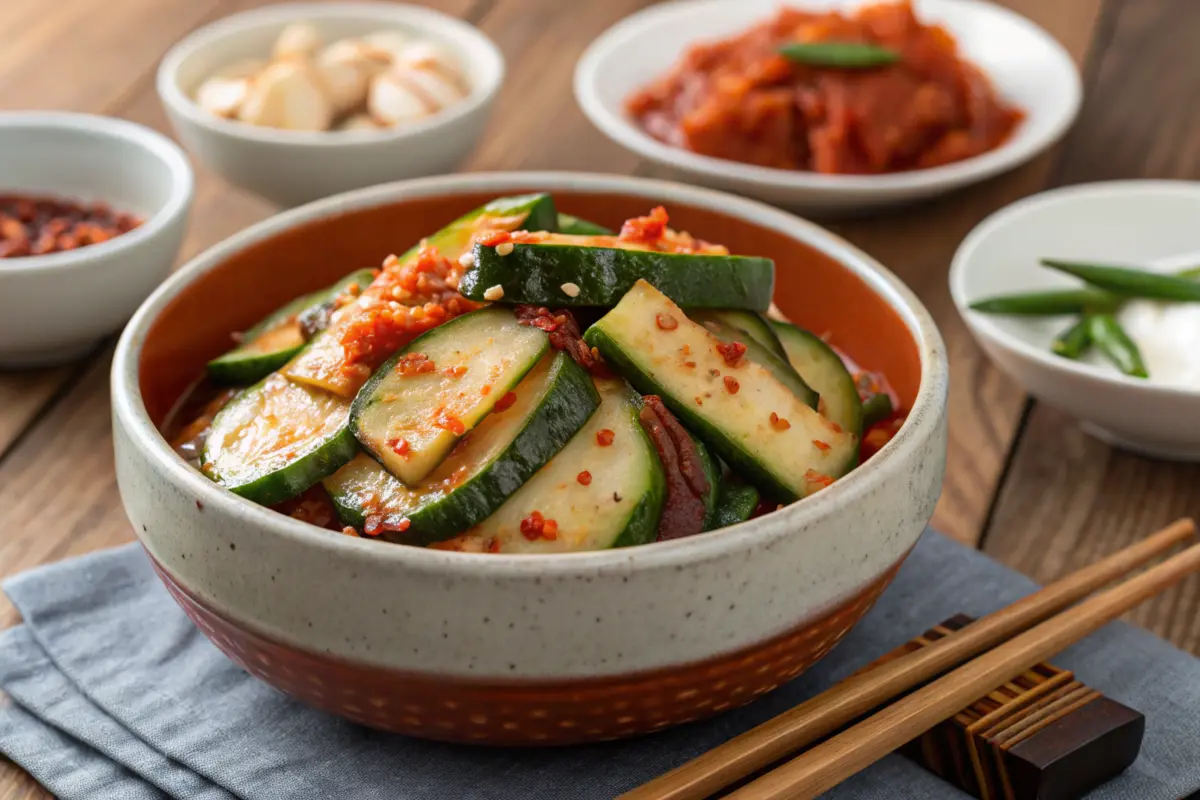Kimchi, the iconic Korean side dish, comes in many forms. While cabbage kimchi is the most famous, cucumber kimchi—known as Oi Kimchi—has earned a special place for its refreshing crunch and spicy kick. But here’s the million-dollar question: Which cucumber is best for kimchi? From traditional Korean cucumbers to versatile Persian and Kirby varieties, the choice of cucumber can make or break your recipe. In this article, we’ll dive deep into the ideal cucumbers for kimchi, explore their unique characteristics, and guide you through crafting the perfect batch of cucumber kimchi.
Let’s start with understanding the basics of cucumber kimchi and why the right cucumber matters.
Introduction to Cucumber Kimchi
What is Cucumber Kimchi?
Cucumber kimchi, or Oi Kimchi, is a variation of traditional Korean kimchi made with fresh cucumbers. Unlike cabbage kimchi, this version offers a lighter, crunchier texture and is often consumed as a quick-fermented side dish. The cucumbers soak up the spicy, tangy marinade, creating a refreshing and addictive flavor profile. It’s a go-to summer delicacy that pairs well with rice, grilled meats, or even on its own.
Importance of Choosing the Right Cucumber
Not all cucumbers are created equal when it comes to kimchi. The right cucumber ensures that the dish retains its crunch, absorbs flavors evenly, and ferments correctly. For instance, cucumbers with a high flesh-to-seed ratio hold up better during the fermentation process. On the flip side, varieties with too many seeds or soft flesh might turn mushy, compromising texture and taste.
Traditional vs. Modern Cucumber Varieties
Traditionally, Korean cucumbers were the gold standard for Oi Kimchi due to their firm texture and minimal seeds. However, as kimchi-making has spread globally, home cooks and chefs alike have experimented with other varieties like Persian, Kirby, and English cucumbers. Each type offers unique benefits, allowing more people to enjoy this dish using locally available produce.
Characteristics of Ideal Cucumbers for Kimchi
Firmness and Texture
Firm cucumbers are crucial for making high-quality kimchi. The firm texture ensures the vegetable retains its crunch, even after the fermentation process. Soft cucumbers, on the other hand, may turn mushy, which can spoil the dish’s overall appeal. Korean cucumbers, known for their crispness, are often the go-to choice for this reason.
Seed Content and Flesh-to-Seed Ratio
The flesh-to-seed ratio is another vital factor. Cucumbers with too many seeds can become watery during fermentation, diluting the flavor of the kimchi. Thin cucumbers, like Kirby or Persian varieties, tend to have fewer seeds and are better suited for this purpose. When considering which cucumber is best for kimchi, always opt for varieties with minimal seeds.
Size and Shape: Slender vs. Thicker Cucumbers
Slender cucumbers, such as Korean or Persian types, are generally preferred for Oi Kimchi. Their uniform size and shape make them easier to slice and stuff, ensuring even fermentation. Thicker cucumbers might require more effort to prepare and often contain a higher seed volume, making them less desirable.
Common Varieties Used in Korea
In traditional Korean kitchens, locally grown cucumbers dominate the scene. These cucumbers are small, thin, and perfectly balanced in terms of texture and flavor. They are specifically cultivated for their suitability in fermented dishes like kimchi. However, as global kimchi-making gains popularity, varieties like Kirby and English cucumbers are becoming more prevalent.
Comparison of Commonly Used Cucumbers for Kimchi

Korean Cucumbers: A Traditional Choice
Korean cucumbers are slim, crisp, and have an excellent flesh-to-seed ratio. They are specifically grown for dishes like kimchi and provide the perfect balance of texture and flavor. Their ability to hold up during fermentation without losing crunchiness makes them the top choice in Korean households.
Persian Cucumbers: A Versatile Alternative
Persian cucumbers are a favorite for their availability and versatility. These small, seedless cucumbers mimic the texture of Korean varieties, making them an excellent substitute. They are widely accessible, making it easier for kimchi enthusiasts outside Korea to replicate authentic recipes.
Kirby Cucumbers: Crispness Retention
Kirby cucumbers are popular for their robust crunch, even after prolonged fermentation. Known for their pickling properties, they make an exceptional choice for Oi Kimchi. Their firm texture ensures they absorb flavors without losing integrity, offering a satisfying bite.
English Cucumbers: The Adaptable Option
English cucumbers, with their long, slender appearance, are another practical option. They are seedless and have a mild flavor, which complements the bold spices of kimchi. However, their thin skin may require peeling to achieve the desired texture.
For more on preparing kimchi with various cucumber types, you might explore this detailed cucumber kimchi guide.
Preparing Cucumbers for Kimchi

Washing and Cleaning
Cleanliness is a critical step when preparing cucumbers for kimchi. Begin by thoroughly rinsing the cucumbers under running water to remove dirt and residue. Using a vegetable brush can help scrub away stubborn particles, especially if you’re working with organic or homegrown produce. Ensuring your cucumbers are clean reduces the risk of unwanted bacteria, which can spoil your kimchi.
Slicing Techniques
The way you slice cucumbers can greatly influence the outcome of your kimchi. For quick kimchi recipes, cutting cucumbers into bite-sized chunks or thin slices works best. If you’re making stuffed cucumber kimchi (Oi Sobagi), slit each cucumber lengthwise, leaving enough space to hold the spicy stuffing. Uniform slices or slits promote even fermentation, allowing the marinade to penetrate each piece.
Salting and Dehydration
Salting is a vital step in preparing cucumbers for kimchi. Sprinkle coarse sea salt over the cucumbers and let them sit for 20-30 minutes. This process draws out excess moisture, helping the cucumbers stay crunchy during fermentation. After salting, rinse the cucumbers lightly to remove excess salt but retain a subtle salty flavor that enhances the kimchi marinade.
Recipes and Tips for Perfect Cucumber Kimchi
Quick Cucumber Kimchi Recipe
If you’re short on time but still crave kimchi, a quick cucumber kimchi recipe is your answer. Combine thinly sliced cucumbers with a marinade of gochugaru (Korean chili flakes), garlic, ginger, fish sauce, and sugar. Mix well, ensuring every slice is coated. Let it sit for an hour, and you have a fresh, vibrant kimchi that’s ready to enjoy.
Spicy Stuffed Cucumber Kimchi
For those who want to try something traditional, Oi Sobagi is the way to go. Start by slitting cucumbers lengthwise and stuffing them with a flavorful mix of julienned carrots, green onions, garlic, and gochugaru. This method creates a more intense flavor profile as the stuffing ferments along with the cucumber.
Tips for Enhancing Flavor and Longevity
- Use Fresh Ingredients: Fresh cucumbers and high-quality spices make a noticeable difference.
- Ferment in a Cool Spot: Ensure consistent temperature to avoid overly sour kimchi.
- Adjust Salt Levels: Proper salting ensures the kimchi stays flavorful while preventing spoilage.
If you’re exploring fermented foods, check out this comprehensive kimchi guide.
With these recipes and preparation tips, you can create your perfect batch of cucumber kimchi. By selecting the right cucumber and mastering these techniques, you’ll never have to wonder again,
FAQs and Expert Insights
What is the best cucumber for quick kimchi?
For quick kimchi, thin-skinned varieties like Persian cucumbers or Kirby cucumbers work best. Their firm texture and minimal seeds allow for faster fermentation and a satisfying crunch. These cucumbers also absorb the marinade evenly, making them ideal for recipes requiring short preparation time.
Can I use any cucumber for kimchi?
While you can use most cucumbers for kimchi, the results may vary. Soft cucumbers or those with thick skins might lose their crunch during fermentation. To ensure the best outcome, choose firm, slender cucumbers with fewer seeds, such as Korean, Persian, or Kirby varieties.
How do cucumbers impact fermentation?
Cucumbers play a crucial role in the texture and flavor of kimchi. Their water content, flesh-to-seed ratio, and firmness affect how well they hold up during fermentation. The right cucumber ensures a crunchy texture and enhances flavor absorption.
What are the differences between Korean and Persian cucumbers in kimchi?
Korean cucumbers are traditional, known for their slim size and crisp texture. Persian cucumbers are a versatile substitute, offering a similar crunch and flavor, making them a popular alternative for those outside Korea.
Conclusion and Recommendations
Crafting the perfect cucumber kimchi begins with selecting the right cucumber. As we’ve explored, firm, slender varieties like Korean, Persian, and Kirby cucumbers excel in delivering that signature crunch and absorbing the spicy marinade. By understanding their unique characteristics, you can confidently answer the question, Which cucumber is best for kimchi?
Preparation is just as vital as selection. From thorough washing to precise slicing and proper salting, each step ensures your kimchi is flavorful and long-lasting. Whether you opt for a quick cucumber kimchi recipe or dive into the art of stuffed Oi Sobagi, the journey to delicious kimchi starts with fresh, high-quality cucumbers.
Common Mistakes and How to Avoid Them
Overlooking the Importance of Cucumber Choice
One of the most frequent errors in making cucumber kimchi is not considering the type of cucumber used. Soft, overripe cucumbers can lead to a mushy texture, while thick-skinned varieties may not absorb the marinade effectively. To avoid this, always prioritize firm, slender cucumbers like Korean, Persian, or Kirby varieties. By asking yourself, Which cucumber is best for kimchi?, you’re already on the right track.
Skipping the Salting Step
Salting is a crucial step that many people underestimate. It helps remove excess water from the cucumbers, ensuring they stay crunchy throughout fermentation. Skipping or rushing this step can result in watery kimchi with a diluted flavor. Make sure to allow enough time for salting, and don’t forget to rinse off excess salt before adding the marinade.
Using Low-Quality Ingredients
The flavor of cucumber kimchi heavily depends on the quality of ingredients. Fresh cucumbers, authentic gochugaru (Korean chili flakes), and premium fish sauce are essential for achieving the best results. Avoid cutting corners by using subpar substitutes, as this can compromise the taste and texture of your kimchi.
Exploring Creative Variations of Cucumber Kimchi
Fusion Flavors: Cucumber Kimchi with a Twist
Who says kimchi has to follow tradition to the letter? Experimenting with fusion flavors can breathe new life into your recipes. Add ingredients like lemongrass, Thai basil, or even citrus zest to give your cucumber kimchi a unique spin. These additions complement the spicy-sour base and create a fresh, vibrant taste.
Incorporating Seasonal Vegetables
Pairing cucumbers with seasonal vegetables like radishes, carrots, or bell peppers not only enhances the visual appeal but also adds layers of flavor and texture. For example, shredded carrots can bring a subtle sweetness that balances the heat of the gochugaru.
Spicing Things Up
If you love a fiery kick, consider adding extra chili or experimenting with different spice blends. Combining gochugaru with cayenne or smoked paprika can yield a deeper, more complex flavor profile. Just remember to adjust the spice level to suit your taste buds.

